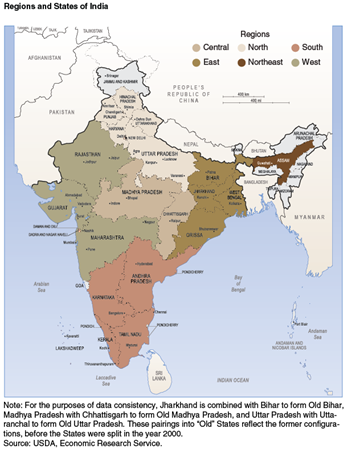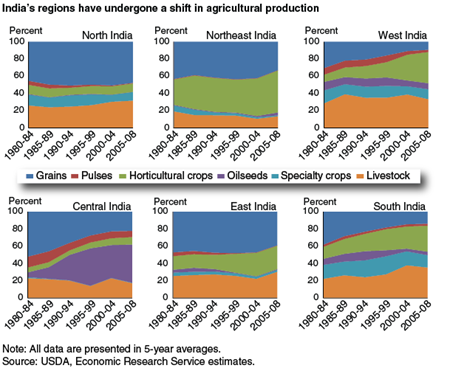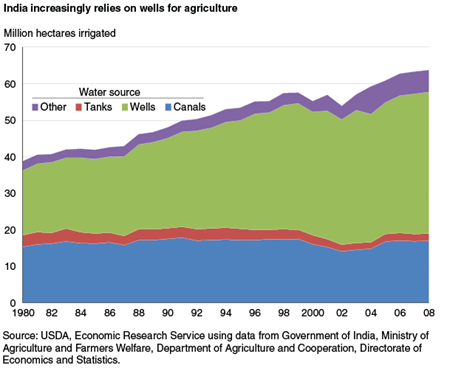India’s Agricultural Growth Propellers

Highlights:
-
Productivity was the key driver of India’s 1980-2008 agricultural growth, which has expanded beyond the Northern grain belt and toward high-value agriculture in traditionally less productive regions.
-
Long-term investments in agricultural research and irrigation infrastructure have been primary propellers of growth in India’s agricultural total factor productivity, although their benefits vary by region. Workforce education has also boosted productivity.
-
More recently, expansion of irrigated area accounted for roughly one-third of crop output growth in India, while yield advancements and the shift to high-value commodities accounted for the remainder.
Since the 1980s, Indian agriculture has undergone a shift in production as farmers have planted less area to food grains and more to high-value crops. This shift coincides with strong economic growth, which has boosted incomes and, in turn, expanded consumer demand for higher valued foods, such as fruit, vegetables, milk, and some meat products. Yet, India’s agricultural policies continue to follow a Green Revolution strategy developed to achieve grain self-sufficiency in the 1960s. That strategy focuses on investments in agricultural research, irrigation, transportation, and market infrastructure, and on output and input price supports to intensify grain production, particularly in the North region of the country.
In light of the apparent divergence between farm production and Indian Government policy, ERS researchers evaluated India’s post-1980 agricultural performance to assess the policies and factors propelling agricultural growth. Specifically, the researchers questioned whether long-term investments in agricultural research and irrigation investments, among other factors, continue to be the primary drivers of India’s agricultural productivity growth and how their impacts may have changed over time.
Shifting Sources of Agricultural Growth in India
The researchers began by compiling the broadest dataset of commodities produced in India among studies to date at the national, regional, and State levels. The commodities include 59 crops (grains, pulses, horticulture crops, oilseeds, and specialty crops) and 4 livestock products, which give a unique perspective on the sources of agricultural growth. A comparison of average production shares in 1980-84 and 2004-08 shows that animal and horticulture production in India increased over time at the expense of grains.
Disaggregating the analysis by region provides greater insight into India’s shift in production during the period. In the North, where input-intensive grain production is highly subsidized, farmers have little incentive to diversify crop production and thus deepened their specialization in grains. In the Indian West, East, Northeast, and South, horticulture crops had the fastest growth. This was particularly true for the States of Gujarat, Rajasthan, Maharashtra, West Bengal, and Andhra Pradesh. Factors that spurred the production shift to higher valued commodities include rising domestic and international demand for fruits, vegetables, and animal products; increased economic empowerment of women and urbanization; greater private-sector participation in retail marketing and agricultural input supply; improved transportation and market infrastructure; and favorable investment policies in the food processing industry.
While Eastern and Northeastern India transitioned to high-valued crops, they have not experienced similar growth as those which diversified away from grains. This is likely due to deficiencies in transportation and market infrastructure and post-harvest technologies. Also, incomes are lower in these regions and may be insufficient to create the demand for high-valued commodities required to incentivize greater growth.
As a result of India’s production shifts, agricultural output growth over 1980-2008 averaged 3.1 percent. Roughly 66 percent of that growth was attributed to total factor productivity (TFP), or producing more output from the same amount of inputs. Stated differently, 66 percent of India’s agricultural growth was due to the introduction of new technologies and other efficiency improvements. However, India’s agricultural TFP growth varied substantially by region. India’s North, Northeast, and East regions were notably below the national average (2.1 percent per year), while West India, conversely, achieved faster-than-average growth. The wide year-to-year swings in TFP growth of the West region typify Indian rainfed agriculture, in which production responds to variable rainfall patterns. Among all regions, South India had the fastest average TFP growth, reaching 2.7 percent annually. Common among States in the South was a broad shift to high-value crops; strong growth in specialty crops, such as cotton and sugarcane; and, since 2004, flat or negative growth in agricultural input use.
Policy reforms and new technology adoption likely played a role in West India’s TFP growth surge that began in 2004. State lawmakers in Gujarat amended the Agricultural Produce Market Committee Act to waive marketing fees for selling farm commodities and allowed private companies to contract directly with horticultural producers. Additional initiatives in Gujarat include the promotion of micro-irrigation systems paired with subsidized loans and a streamlined administrative process, and the Jyotigram Scheme. The Jyotigram Scheme separated agricultural from nonagricultural power supplies, providing farmers 8 hours of full-voltage power at anticipated times, and limited competitive pumping for groundwater in a State with primarily rainfed agriculture (64 percent).
Investment in Research a Major Propeller of Long-Term Total Factor Productivity Growth
A major driver of India’s long-term TFP growth has been investments in agricultural research. India’s public agricultural research system is based on the university land-grant system pioneered by the United States. In the Indian system, public agricultural research spending also includes investments in higher education. India’s two-tiered research system is made up of the Indian Council for Agricultural Research (ICAR) at the Federal level and State Agricultural Universities (SAUs) at the State level.
Private investment in agricultural research in India is becoming increasingly important, especially in seeds. Private seed-research investment rose from $1.3 million in 1984-85, to $4.9 million in 1994-95, to $88.6 million in 2008-09. The 2008-09 private seed-research investment was more than double that devoted to either of the next two largest private research areas, pesticides ($36 million) and machinery ($41 million). Most of the private seed investors were Indian companies--multinationals invested less than half ($39 million) of total private seed research targeted to Indian agriculture in 2008-09. Private research expenditures for pesticides and machinery also grew during the period, though not at the pace of those for seeds.
In many cases, public research and private research are complementary efforts. For example, the most common drought-tolerant rice varieties were developed from public improvement of inbred lines later used primarily by resource-poor farmers. Other varieties were developed by multinationals and Indian seed companies as hybrids from public inbred lines that could yield up to 30 percent more under irrigation. Some Indian private seed companies are known for producing and marketing hybrids developed directly from public inbred lines.
Regardless of India’s agricultural output mix over time and across regions, public investment in the country’s ICAR-SAU agricultural research system has been the primary mechanism for stimulating agriculture’s long-term TFP growth. Every dollar spent on public research adds about 18 dollars to India’s agricultural output in present-value terms. However, the benefits generated by India’s public agricultural research have been uneven across regions. TFP in the North, West, and Central regions rose more quickly from public research investments than that in other regions.
Despite its contribution to agricultural productivity growth, India’s research system has seen a decline in the number of full-time equivalent scientists working at State Agricultural Universities, as well as the SAUs’ share of total public research funds allocated to the entire agricultural research system. Yet, the number of SAU institutions has proliferated, rising from 31 in 2005 to 70 in 2014. Barring a substantial increase in scientific funding, it is unclear whether ongoing institutional reforms of India’s agricultural research system and reductions of scientific labor by its State Agricultural Universities will allow spending to shift to new research priorities or if the public research system may be headed for stagnation.
Of further concern is India’s ability to keep pace with the world’s agricultural technology leaders. Many of today’s agricultural technologies generated in developed countries cannot be easily adapted by developing countries. India’s agricultural research intensity ratio—defined as research spending per unit of agricultural gross domestic product—allows for international comparison of agricultural research investments. India’s ratio in 2008 was 0.40, lagging China (0.50) and Brazil (1.80) and even further below that of South Korea (2.30), Australia (3.56), and Japan (4.75). The substantial gap relative to such agricultural technology leaders may inhibit future adaptation of the latest technologies.
Investments in Irrigation Are Also Key
India’s agricultural sector has also been propelled by investments in irrigation infrastructure. Because India operates a mainly rainfed agricultural system, it has long invested in irrigation capital to mitigate weather risk and stimulate production. India uses 13 percent of the world’s extracted water each year, and 87 percent of that water is used in irrigation. In the 1980s, India was the world’s third-largest groundwater user; today, it is the largest groundwater user. Groundwater from wells has become the country’s dominant source of irrigation. India’s move to groundwater irrigation is not surprising given the geographic constraints on access to canal water. The robust growth of groundwater irrigation reflects innovations that have boosted production by allowing more land to be double cropped in a country that has seen no expansion of its land resource base. Double cropping is the practice of consecutively growing two or more crops on the same piece of land in a single growing season.
Indian farmers’ shift to well irrigation has expanded area that may be double cropped, boosting productive capacity beyond that achieved through canal irrigation. Expanding groundwater well irrigation raises TFP more than does surface-water canal irrigation, and expanding total irrigated area benefits TFP more in the Indian North and West than in the rest of the country.
Pointing to irrigation’s role in double cropping, Gujarat’s gross irrigated area between 2000-01 and 2006-07 expanded most rapidly under wheat, cotton, fruits, and vegetables. Although wheat-irrigated area expanded fastest, the presence of irrigation has likely drawn farmers to horticulture. However, in Tamil Nadu State, output shifts to high-value crops were found to boost incomes in the presence of irrigation but to have no impact in rainfed areas. For areas lacking a consistent water supply, a shift to high-value output functioned as a form of insurance rather than a source of income.
Education Also Matters
Years of schooling can also affect TFP growth, as educational attainment can facilitate the adoption of new farm technologies by farm labor. India has rather low levels of public education; 3.4 years of schooling is the national average. TFP growth in agriculture was relatively slower in those States with workforce education levels at or below the national average and faster in those States with higher workforce education. Once a State’s per capita average education level reaches 4.3 years, TFP growth accelerates. Thus, India’s low education levels have acted as a drag on agricultural productivity growth.
Drivers of More Recent Agricultural Growth
Average annual growth in India’s real (2004 constant) total agricultural value accelerated from 2.9 percent over 1980-2004 to 7.5 percent over 2004-08. Some argue that acceleration was attributable to private capital formation, improved agricultural trade terms, and subsidies for credit, fertilizer, and higher quality seed. Others point to India’s shift to higher valued commodities. Often omitted as a contributing factor is irrigation.
An analysis of growth in crop output since 1980 shows that 13 percent of India’s 2.8-percent crop growth between 1980 and 2008 is accounted for by irrigation-induced area expansion, 55 percent is due to greater yield growth, and 32 percent is due to producing new crops to meet high consumer demand. But yield’s share of crop growth has declined steadily since 1980, while output growth shares associated with irrigation-enabled area expansion and new-product growth have steadily increased over the same period. Between 2004 and 2008, these two sources accounted for 60 percent of crop growth. While irrigation has boosted growth, excessive groundwater extraction has led to severe groundwater depletion in the hard-rock areas of peninsular India and parts of the arid alluvial plains in Northwest India, which could limit water supplies in the future, and thus limit further growth.
Propellers of Agricultural Productivity in India, by Nicholas Rada and David Schimmelpfennig, USDA, Economic Research Service, December 2015
“India’s Post-Green-Revolution Agricultural Performance: What is Driving Growth,” by Nicholas Rada, Agricultural Economics , Volume 47, Issue 3, May 2016






